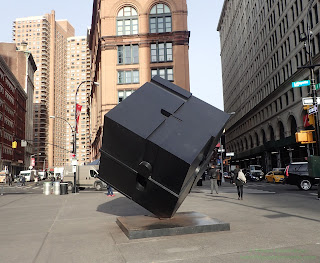 The New York City parks department lists 843 permanent artworks on its sites, including monuments, fountains, mosaics and other styles. Astor Place’s cube named "Alamo" was the first permanent contemporary outdoor sculpture installed in New York City. It was created by American artist Tony Rosenthal, best known for his monumental public art sculptures. His art dealer Sam Kootz, who also represented Pablo Picasso, not only convinced to use the nickname "Tony" instead of his real name Bernard. Koots also recommended the artist name to concentrate on creating abstract geometric sculptures.
The New York City parks department lists 843 permanent artworks on its sites, including monuments, fountains, mosaics and other styles. Astor Place’s cube named "Alamo" was the first permanent contemporary outdoor sculpture installed in New York City. It was created by American artist Tony Rosenthal, best known for his monumental public art sculptures. His art dealer Sam Kootz, who also represented Pablo Picasso, not only convinced to use the nickname "Tony" instead of his real name Bernard. Koots also recommended the artist name to concentrate on creating abstract geometric sculptures. Alamo was originally created for a citywide exhibit, put on by the New York City Parks Department, called “Sculpture in Environment.” The sculpture's name, Alamo was selected by the artist's wife because its scale and mass reminded her of the Alamo Mission.
 |
| Spanish Mission |
In the same year, 1967, Rosental also created cube in Detroit.
These two cubes were the first ones but not the last ones created by the sculptor. A year later in 1968 a cube in Ann Harbor, Michigan was created. In 1972 similar cube appeared in New London, Connecticut.
 |
| Cube in Michigan |
 |
| Cube in Detroit |
The Cube was removed from its spot in 2014 in order to facilitate the renovation of the public space, including the addition of seating and more pedestrian plazas. The cube returned to its place in 2016.


No comments:
Post a Comment